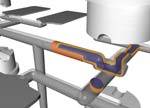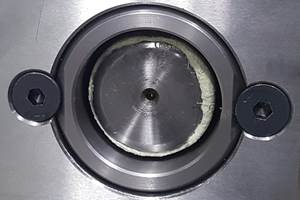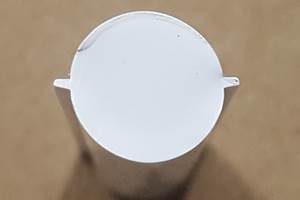What to Do When the Mold Just Won't Fill Right
What should have been a routine injection molding job was plagued with problems right from the start.
What should have been a routine injection molding job was plagued with problems right from the start. The parts were small and simple. The mold had only four cavities and a straightforward cold runner. Still, the cavities didn’t fill evenly and the parts didn’t pass muster. For Wilco Molding Inc., a custom molder of medical and industrial parts in Maryland Heights, Mo., the cure for this headache turned out to be a new type of runner modification that overcomes the natural tendency of many geometrically balanced molds to fill in an unbalanced manner.
The troublemaker was a 1.5-in.-diam. timing ring for an automatic fire-suppression sprinkler’s flow-switch assembly for Potter Electric Signal Co. “We didn’t make the ring previously, but the design had been upgraded for the first time in 16 years,” recalls Wilco general manager Kim Williams.
The timing ring was molded of 30% glass-filled polycarbonate. Wilco molds almost exclusively glass-filled engineering resins. Wilco also built the cold-runner system for the four-cavity mold in its tool shop. “We’ve manufactured many cold-runner systems like this. It is a simple, straightforward application,” said Williams.
Not flat, not good
The ring had one major quality criterion: It had to be flat. It contained a 0.007-in.-diam. groove that had to be flat to ±0.0005 in.
The mold was designed with three gates per cavity positioned at spokes in the part. Wilco believed the tool was “naturally balanced,” but filling problems suggested otherwise. “The gates closest to the sprue would fill out first,” says Williams. “When filling the remaining portions of the cavities, the area in the part closest to the first gates would overpack and distort the spokes. The ring then would not lay flat in the mating seal component, making all four parts and the assembly unusable.” Unbalanced filling created knit lines along visible areas in the part, which also led to part failures. Wilco was experiencing around 30% scrap from incompletely filled parts and couldn’t use the remaining parts either. The scrapped parts appeared in different cavities each time the machine was set up and run.
Changing to a two-cavity mold was not an acceptable alternative because Wilco was to produce 300,000 units a year and had scheduled production on a single machine. Wilco tried varying the packing pressure, which provided only temporary improvement.
Flip the melt flow
Trying to attain uniform cavity filling led Mike Van Duine, technical service representative for Wilco’s material supplier, General Polymers Div. of Ashland Distribution Co., to suggest that Wilco investigate the patented MeltFlipper technology from Beaumont Technologies Inc. (BTI). The MeltFlipper is designed on the premise that “geometrically balanced” runner systems do not account for shear-induced flow imbalances. Shearing of the melt along the runner walls creates hotter, less viscous material on the outside edges of the runner channel and cooler more viscous material in the middle of the melt stream. At the first branch or split in the runner channel, the flow splits into two streams that are half hot and half cool. At the next runner branching, the flow becomes asymmetrical, with the hotter, less viscous material flowing along one side of the wall and the cooler material flowing on the opposing wall.
To correct the imbalance, BTI developed the MeltFlipper, an insert installed at an intersection of a branching runner that rotates the melt’s orientation 90° so that the hotter less viscous material is at the bottom of the flow channel and the cooler, viscous material is on top. This top-and-bottom orientation of the melt, instead of side to side, stays constant even as the melt flows through secondary and tertiary branches. Hence, the melt enters each cavity with the same fill rate and pressure.
Wilco purchased a MeltFlipper license. BTI reviewed prints of the runner layout, designed appropriate MeltFlipper inserts, and suggested where and how the inserts should be installed. Wilco machined the inserts and installed them in two locations—at the primary/secondary runner intersection and just before the subgates serving each cavity. The rest of the tool and the process parameters were unchanged.
The MeltFlipper solved Wilco’s problem quickly. “An hour after start-up and production-level operation, we reduced our scrap to zero,” says Williams.
BTI has licensed more than 1000 MeltFlipper applications in the U.S. since its commercial introduction in 1998. Most of them have eight or more cavities, but the Wilco case shows that MeltFlipper can benefit even lower-cavitation molds.
Related Content
What You Need to Know About Leader Pins and Bushings
There’s a lot more to these humble but essential mold components than you might suspect. Following the author’s tips could save much time, money and frustration.
Read MoreWhere and How to Vent Injection Molds: Part 3
Questioning several “rules of thumb” about venting injection molds.
Read MoreImprove The Cooling Performance Of Your Molds
Need to figure out your mold-cooling energy requirements for the various polymers you run? What about sizing cooling circuits so they provide adequate cooling capacity? Learn the tricks of the trade here.
Read MoreWhy Shoulder Bolts Are Too Important to Ignore (Part 1)
These humble but essential fasteners used in injection molds are known by various names and used for a number of purposes.
Read MoreRead Next
New Runner-Design Concept Boosts Quality & Productivity
Why 'naturally balanced' multi-cavity molds sometimes refuse to fill evenly is a mystery that eluded solution—until now. A simple concept called the MeltFlipper allows molders to increase cavitation and maximize output of quality parts.
Read MoreHow Polymer Melts in Single-Screw Extruders
Understanding how polymer melts in a single-screw extruder could help you optimize your screw design to eliminate defect-causing solid polymer fragments.
Read MoreProcessor Turns to AI to Help Keep Machines Humming
At captive processor McConkey, a new generation of artificial intelligence models, highlighted by ChatGPT, is helping it wade through the shortage of skilled labor and keep its production lines churning out good parts.
Read More



























